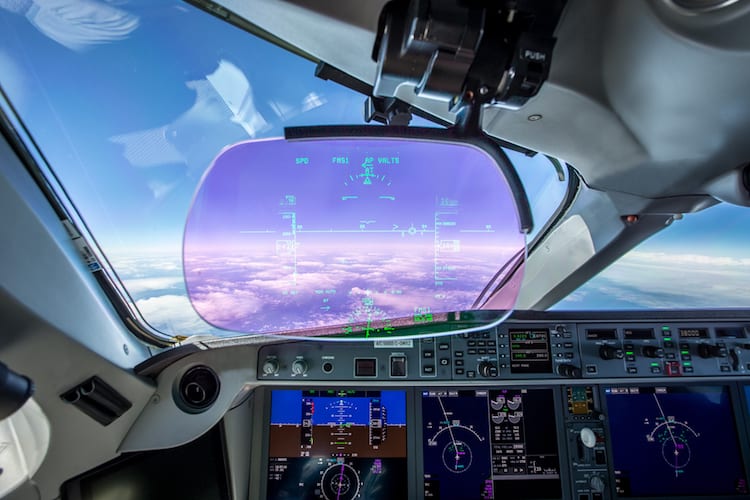
Airbus A220-100 cockpit with head up display (HUD). Photo, courtesy of C Series Aircraft Limited Partnership.
The Airbus A220 has achieved category III (CAT III) autoland flight operational approval from the European Aviation Safety Agency (EASA), giving pilots flying the regional airliner the ability to land in low visibility conditions.
EASA revised the Airbus A220’s European type certification Nov. 30 to reflect the introduction of CAT IIIA and B autoland operations. The European civil aviation regulator defines CAT III autoland operations as precision instrument approaches with decision heights lower than 100 feet and runway visibility of less than 250 feet.
A representative for the Airbus A220 program confirmed that the aircraft has achieved CAT IIIA and B approval from civil aviation certification bodies in Canada, Europe and the United States.
“We have to demonstrate that the autoland system meets the robustness and the performance requirements of the regulations. This is achieved via thousands of auto-landings in simulation environments and hundreds of auto-landings on our A220 flight-test vehicles,” the representative said.
Airbus A220 aircraft are equipped with the Collins Aerospace Pro Line Fusion flight deck and a standard heads-up display (HUD) system. Esterline CMC supplies the aircraft information server (AIS) for the aircraft.
By achieving the CAT III autoland approval, pilots flying the A220 can now use the aircraft’s HUD system in combination with its autopilot functionality to land in low visibility conditions. Flying CAT III approaches in aircraft featuring a HUD can vary based on airline policy. However, it is significantly different than flying in an aircraft with no HUD, says Dennis Tajer, a Boeing 737 captain for American Airlines and communications committee chairman for the Allied Pilots Association (APA).
Tajer, who has flown CAT III landings for several years in the 737, said that CAT III approaches do not happen often but are extremely beneficial to pilots flying in low visibility conditions.
“It gives pilots the ability to land in conditions with very low visibility runway visual range to the point where basically right at 50 feet above the ground is when you’ll start to see the actual runway. Usually the captain is focused on the aircraft’s position represented by a donut on the HUD and keeping that donut in line with the flight guidance system. Meanwhile, the first officer monitors the approach and alert panel,” said Tajer.

Delta Airlines’ first Airbus A220 will fly commercially in January. Photo, courtesy of Delta.
The update marks the first major operational modification to the A220’s type certification since Airbus acquired the former C Series program from Bombardier. Airbus officially closed on its 50.1 percent majority stake in the C Series Aircraft Limited Partnership July 1, 2018. Bombardier still owns 34 percent. Investissement Québec holds 16 percent.
According to the latest fleet data from Airbus, there have been 47 total deliveries of the A220. AirBaltic, Korean Air and SWISS have completed a combined 90,000 revenue flights across more than 123,000 flight hours and 150 routes with the aircraft.
Delta became the first U.S. carrier to take delivery of the A220-100 on Oct. 12, 2018, and will start flying it on revenue flights Jan. 31, 2019.
The C Series Aircraft Limited Partnership currently has 355 back logged orders for the $81 million A220.